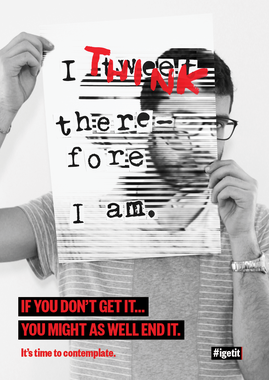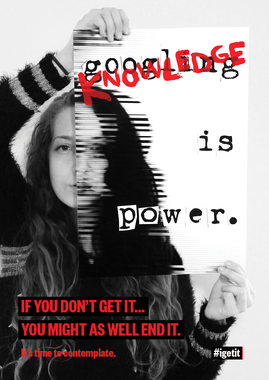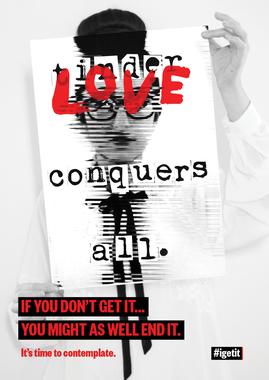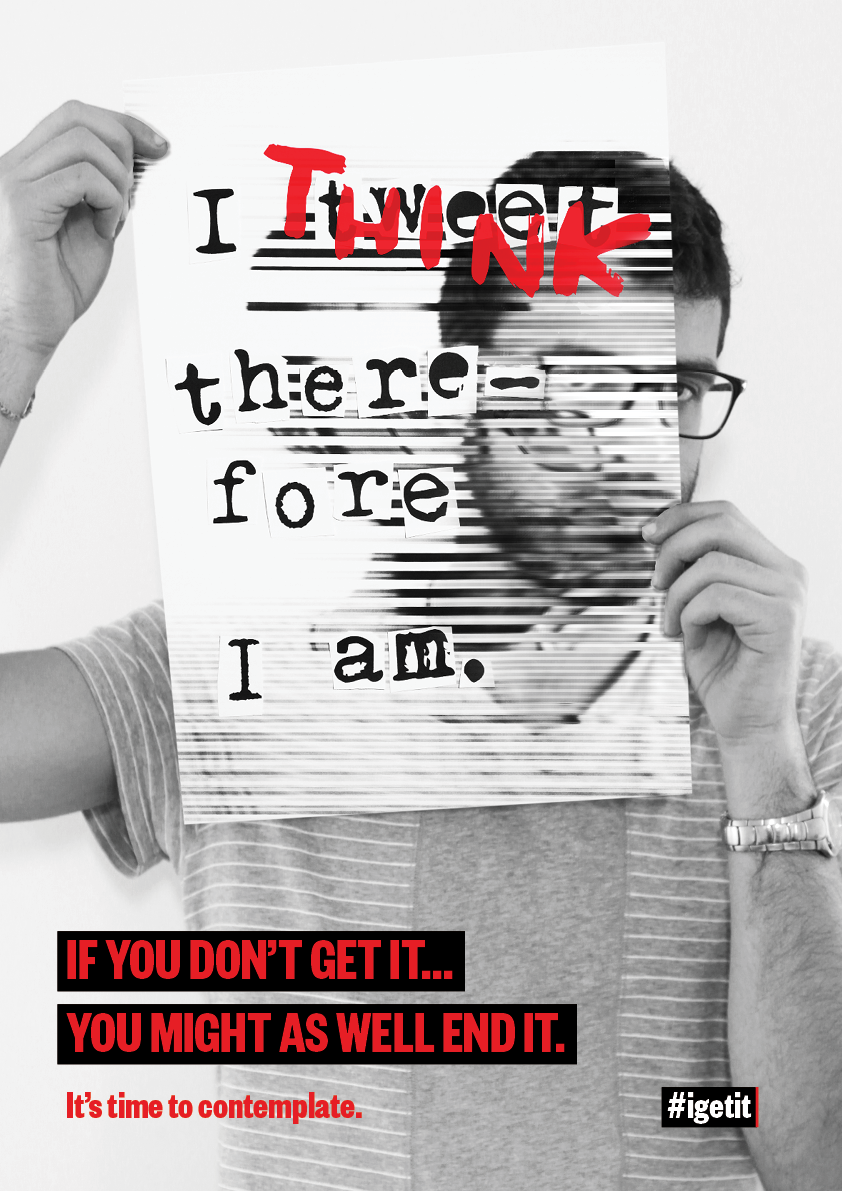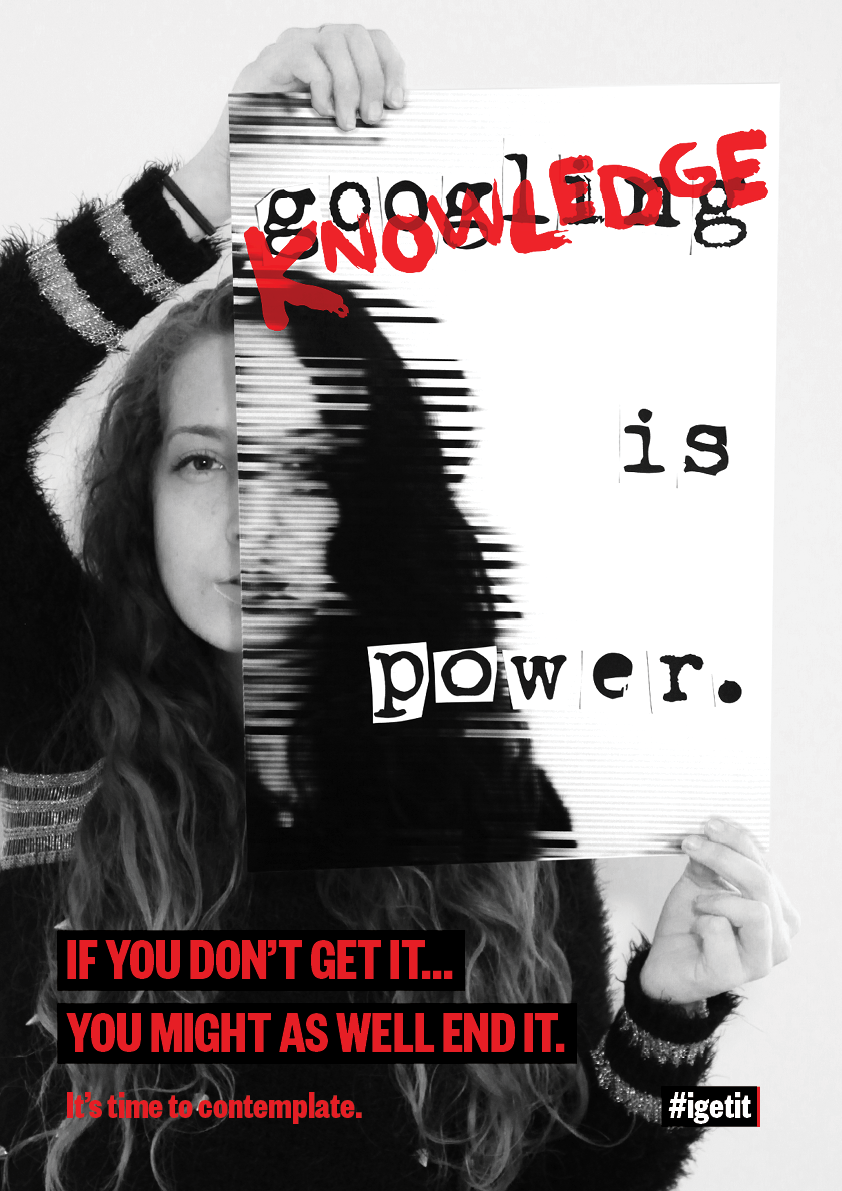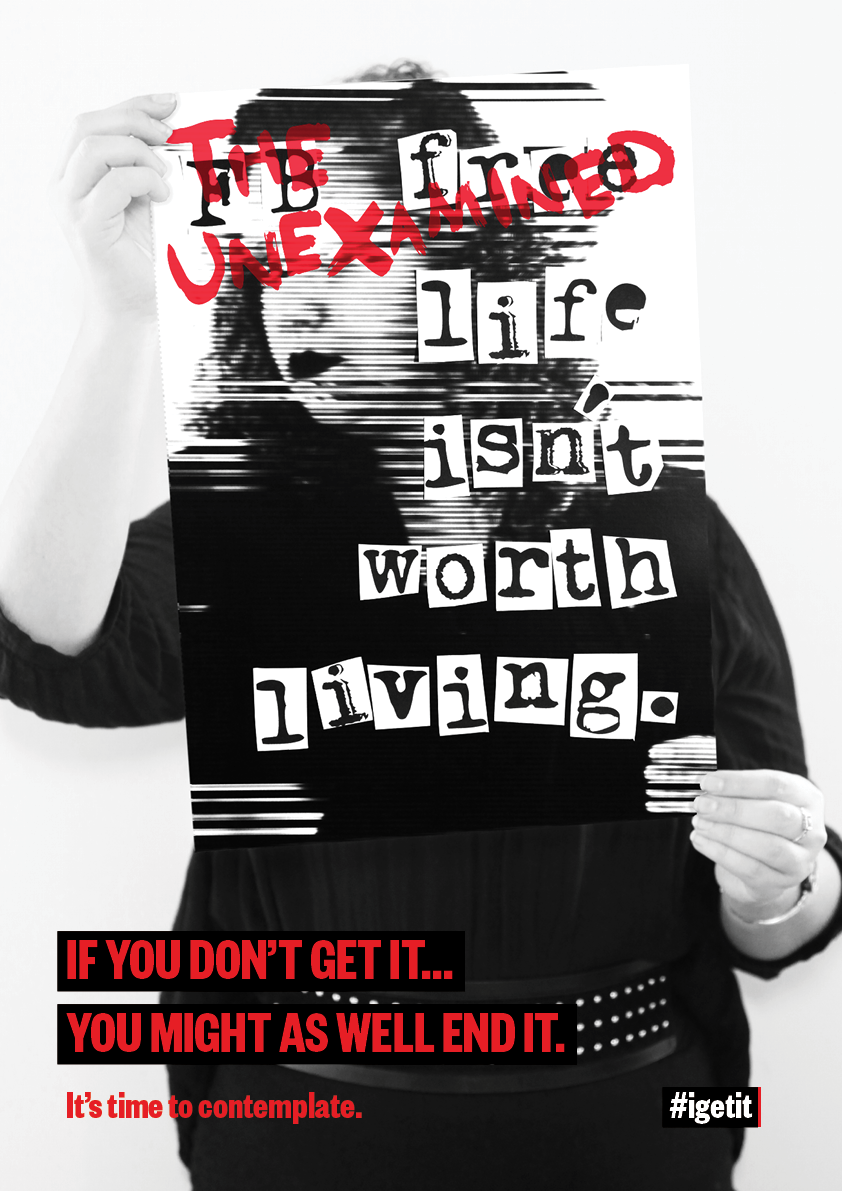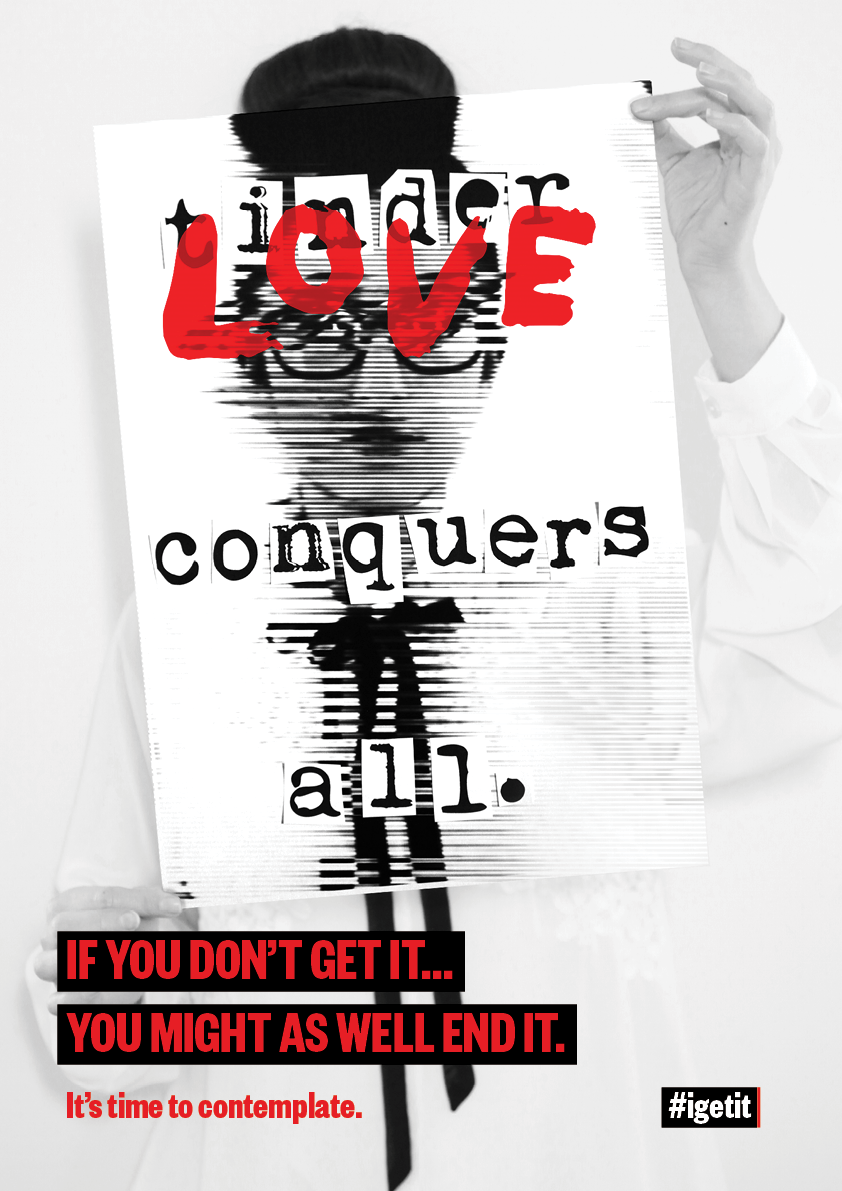It's time to contemplate
by natanamayer
This work has been commented by 1 curator(s). Read the comments
Title
It's time to contemplate
Headline
If you don't get it...you might as well end it.
Concept author(s)
Natana Mayer
Concept author year(s) of birth
1993
Concept author(s) contribution
Photographer, graphic designers, creative director, finishing artist, copywriter, model....basically everything.
Concept author(s) Country
Australia
Friendly Competition
Radical intimacies: dialogue in our times (2014)
Competition category
Visual communication practice
Competition subcategory
static
Competition field
academic
Competition subfield
student
Subfield description
Swinburne University
Check out the Radical intimacies: dialogue in our times 2014 outlines of Memefest Friendly competition.
Description of idea
Describe your idea and concept of your work in relation to the festival outlines:
“IT’S TIME TO CONTEMPLATE” is a multimedia campaign that poses contrasting quotes to invoke personal contemplation on the intimate role screen culture plays in our day-to-day lives. Intimate consumption of the internet highlights a strong disconnect between private and public spheres. The campaign is not about reducing screen time, but rather putting it into context with the important things in life through inner dialogue.
What kind of communication approach do you use?
The campaign uses an introspective approach to communication. The campaign aims to encourage the most overlooked form of dialogue- inner dialogue. Using a tongue in cheek approach, the campaign contrasts two quotes; a philosophical quote about life, and a modern day internet-centric re-adjustment of that very same quote. These small changes produce a confronting juxtaposition that starts a process of introspection concerning the intimate relationship one has with the online sphere. The tagline “If you don’t get it…you might as well end it. It’s time to contemplate” uses shock value and ambiguity to drive the viewer to actively seek meaning in the campaign. The tagline challenges the viewer’s intelligence and comprehension by asking them to “get it”. Failure to do so offers a confusing outcome as the viewer is told to “end it” – end what? Their online life? Their Internet obsession? Their real life? The viewer is driven to introspection as they are called upon to contemplate the questions raised above and are encouraged to respond online through the hashtag igetit.
What are in your opinion concrete benefits to the society because of your communication?
The campaign is targeted at teenagers and young adults aged 15-25. Through the increased introspection instigated by this campaign, society will benefit from a more focused collective of today’s youth – the future leaders of tomorrow. The young target audience will be able to engage in life in a more meaningful way that will greatly enhance their contributions to society. The increased perspective will help the youth and young adults to take a step back from their intimate online behaviours and attitudes in favour for engaging with their local public sphere.
What did you personally learn from creating your submitted work?
Through the creation of my work I gained insight into my personal intimate relationship with screen culture. I have been able to learn from the campaign I have produced and step back from the online sphere. I became aware of the disconnect between our perceived private and public spheres. For example; though facebook is seen to reside in the private sphere, it is very much in the public sphere due to its transparency and our willingness to share intimate moments with people we possibly haven’t spoken to for years. It has made me review what I perceive as ‘public’ and ’private’ and how I engage in dialogue with each sphere. I have also benefited from gaining perspective on the role the internet plays in my life and how I gain meaning and purpose from the dialogue around me.
Why is your work, GOOD communication WORK?
My work is good design work as it uses creative undertones of wit and satire in conjunction with edgy design to effectively communicate my strongly resonating intended message through sock value. My campaign combines two very different ideas to produce meaning and innovation. I feel that this is the purpose of advertising design – to communicate with intent in a meaningful and memorable way that elicits and emotional response.
Where and how do you intent do implement your work?
The campaign is intended to be implemented in the public sphere: as posters in tram shelters, cafes, outside building, and online as twitter responses and social media sharable images.
Did your intervention had an effect on other Media. If yes, describe the effect? (Has other media reported on it- how? Were you able to change other media with your work- how?)
Not yet.
Curators Comments

Dr Zoë Sadokierski
The designer states that the tagline (If you don’t get it…you might as well end it. It’s time to contemplate) "uses shock value and ambiguity to drive the viewer to actively seek meaning in the campaign." Is this appropriate for a target audience of 15-25 year-olds?
It's incredibly dangerous to even abstractly suggest suicide, particularly to young adults, who are still learning to negotiate social pressures and develop independence and strength in the world. Any mention of suicide in mainstream media is legally followed by a information on how to seek help such as a link to Lifeline
https://www.lifeline.org.au/
and a listing of their phone number, which is a free call from any phone, 24-hours a day where professional counsellors offer anonymous help: 13 11 14
Before you exhibit this campaign in any public space including online, it is incredibly important that you contact a service such as Lifeline (above) or http://suicidepreventionaust.org to ensure you are not unintentionally moving into territory where you could provoke dangerous responses in viewers. Public media is powerful, be aware of all potential to miscommunicate – if you are ever even a tiny bit uncertain whether you may be creating something potentially dangerous, you must consult someone with specialised knowledge in the area, such as the services I've mentioned above.
Even if you want to continue this line of copy writing for your campaign, you need to build in some clarity – if your point is it have people "seek meaning in the campaign" through shock tactics, you should provide a link to a website or other material that will allow them to resolve any ambiguity. Suggesting that if I don't understand something, I should contemplate it more without giving me any strategies to do so may leave me feeling more isolated – which is certainly not the response I think you are going for. If I follow a hashtag and find that people have posted mean-spirited comments, again I could feel more confused an isolated.
That said, there are strengths to this work.
This work starts with a strong premise – that inner dialogue is the most often overlooked form of dialogue, and we should spend more time contemplating (or self-reflecting) in order to better understand our relationship with screen media.
The posters are bold and visually arresting. The visual components work well, it's the written copy that needs to be resolved. Perhaps some more research into ways to encourage people to 'contemplate' will give you some prompts on how to make this campaign more effective. Medical educators use reflective writing as a way to help doctors and nurses develop self understanding and a good beside manner:
http://www.monash.edu.au/lls/llonline/writing/medicine/reflective/8.3.xml
Mindful meditation can also be effective in helping people self reflect. See for example:http://www.getsomeheadspace.com/
I think this is a strong idea that has ended up unintentionally miscommunicating your main message – when this happens, it's important to analyse why, and figure out a way to redesign the campaign so it achieves your communication aims. It's more work, but worth it.

